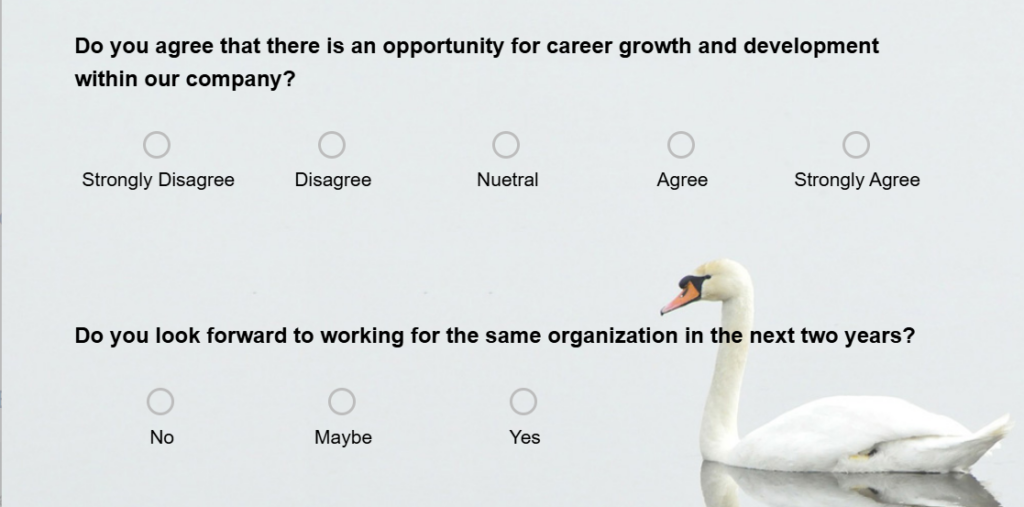
Imagine handling a team with zero cohesion.
Brenda from accounting is doodling cats, Mark from marketing is checking his phone, and the new intern has no clue what needs to be done.
Ouch!
But this is what happens when you have a team with no real connection among its members.
So, it’s time to ditch the forced icebreakers and dive into some data! This guide is packed with team-building survey questions that are fun to answer, easy to implement, and guaranteed to give you valuable insights into your team’s dynamics.
Let’s begin with an awesome tutorial!
What Is a Team-Building Survey?

A team-building survey is a way to understand how well your team-building efforts connect with your team. These surveys reveal what activities help team members bond, what encourages collaboration, and what could be improved to make these efforts more meaningful.
Team survey questions eliminate the guesswork and you get real insights from the team, helping you create experiences they actually find valuable and engaging. As a result, your efforts stay relevant and help build a workplace where people feel more connected and motivated.
Pro Tip: You can also include fun team-building survey questions to break the monotony and encourage your team members to participate.
Team-Building Survey Questions to Ask Your Employees
To create a well-rounded team-building survey, questions should cover different areas that impact both individual experiences and team dynamics. Let’s explore the key categories and example questions for each:
1. Job Satisfaction and Personal Fulfillment
This category focuses on how employees feel about their work and whether it aligns with their personal values and career aspirations. Asking about job satisfaction and personal fulfillment helps you understand if people find their work meaningful, enjoy their roles, and how they feel about their contributions to the company.
These questions are especially valuable after major projects, performance reviews, or organizational changes, as they highlight how people adapt and stay engaged.
Example Questions:
- Do you enjoy your daily work and find it fulfilling?
- Do you find meaning in the work you do here?
- Does your role align with your career goals?
- Do you feel a sense of purpose in your job?
- Are there opportunities for you to pursue personal growth here?
- Do you see a future for yourself within the organization?
These questions can help reveal areas where employees may feel disconnected or unfulfilled, offering a foundation for initiatives that make work more meaningful.
2. Feeling Valued and Recognized
Employees who feel valued tend to be more motivated and engaged. This category looks at whether team members feel recognized and appreciated for their efforts, which can play a significant role in boosting morale and loyalty.
Questions about feeling valued are especially relevant after team-building events, performance milestones, or when there’s been a lot of cross-departmental collaboration, as they reveal if employees feel their contributions are noticed.
Example Questions:
- Do you feel valued and recognized for your contributions?
- Does your manager acknowledge your hard work?
- Do you feel that your opinions are considered and respected?
- Do you believe your efforts make a difference here?
- Do you receive constructive feedback regularly?
- Are there enough opportunities for you to share your ideas?
Insights from this category can guide how managers and team leaders acknowledge and celebrate achievements, ensuring that appreciation becomes a core part of the company culture.
3. Communication and Clarity of Expectations
Effective communication is critical in any team, and this category focuses on whether employees have a clear understanding of their roles, goals, and responsibilities. It’s also about whether managers are transparent and approachable.
These questions help identify areas where miscommunication might occur, reducing potential misunderstandings and helping managers ensure their guidance is crystal clear. Ideally, these questions are asked during performance check-ins or after significant shifts in team responsibilities.
Example Questions:
- Are your job expectations clear and achievable?
- Does your manager communicate expectations effectively?
- Are you aware of how your work contributes to the team’s goals?
- Do you know what success looks like in your role?
- Are you given enough information to perform your tasks well?
- Do you feel comfortable asking for clarification if needed?
Answers here provide managers with a clearer picture of how to improve communication channels and help employees feel confident in their roles.
4. Collaboration and Team Dynamics
For teams to work smoothly, they need a strong sense of trust, mutual respect, and collaboration. Questions in this category assess whether team members feel comfortable collaborating, whether there’s open communication and whether the overall team dynamic is supportive.
These are best asked after team projects or team-building activities, as they provide insights into how well team members are working together and where improvements might be made.
Example Questions:
- Does your team work well together to meet shared goals?
- Are you comfortable sharing your ideas with your team?
- Do you feel supported by your teammates?
- How would you describe the communication within your team?
- Are team members respectful and open to different perspectives?
- Do you feel empowered to collaborate freely with others?
Responses here can guide future team-building activities, helping ensure they foster a genuinely collaborative and open environment.
5. Feedback and Communication with Managers
A healthy manager-employee relationship is built on trust, feedback, and open lines of communication. This category focuses on whether employees feel comfortable giving feedback to their managers and whether they believe their feedback is valued.
This is particularly important for building a transparent culture where everyone feels heard. It’s often best to ask these questions following performance reviews or significant managerial changes.
Example Questions:
- Are you comfortable providing feedback to your manager?
- Does your manager encourage open communication?
- Do you feel your feedback is taken seriously?
- Is it easy for you to approach your manager with concerns?
- Does your manager respond well to suggestions and input?
- Do you feel supported by your manager?
The responses can help managers adapt their approach to make employees feel more comfortable and respected, creating an environment where feedback is genuinely a two-way street.
| Here’s a readymade team-building evaluation form that you can readily use: | |||
|---|---|---|---|
| Do you enjoy your work? | |||
| ☐ Yes, very much | |||
| ☐ Somewhat | |||
| ☐ Rarely | |||
| ☐ Not at all | |||
| Do you feel valued at work? | |||
| ☐ Always | |||
| ☐ Sometimes | |||
| ☐ Rarely | |||
| ☐ Never | |||
| Are your job expectations clear and realistic? | |||
| ☐ Very clear and realistic | |||
| ☐ Somewhat clear and realistic | |||
| ☐ Unclear or unrealistic at times | |||
| ☐ Not clear or realistic at all | |||
| Do you find your work meaningful? | |||
| ☐ Yes, very meaningful | |||
| ☐ Somewhat meaningful | |||
| ☐ Not particularly meaningful | |||
| ☐ Not meaningful at all | |||
| Does your manager communicate expectations clearly? | |||
| ☐ Always | |||
| ☐ Often | |||
| ☐ Occasionally | |||
| ☐ Rarely | |||
| Does your team collaborate effectively? | |||
| ☐ Yes, very effectively | |||
| ☐ Somewhat effectively | |||
| ☐ Not very effectively | |||
| ☐ Not at all effectively | |||
| How challenging is your work? | |||
| ☐ Very challenging | |||
| ☐ Moderately challenging | |||
| ☐ Not very challenging | |||
| ☐ Not challenging at all | |||
| Are you comfortable giving your manager feedback? | |||
| ☐ Very comfortable | |||
| ☐ Somewhat comfortable | |||
| ☐ Not very comfortable | |||
| ☐ Not at all comfortable |
Want to create your own team-building questionnaire for employees? ✨
What Are the Benefits of a Team-Building Survey?
Team-building surveys offer several valuable benefits, making them a powerful tool for improving team dynamics, engagement, and productivity. Here’s how they can make a positive impact:
- Identify Areas for Improvement
Team-building surveys provide clear insights into what’s working well and what isn’t. By gathering feedback on team dynamics, communication, and collaboration, you can identify specific areas that may need attention, such as clearer communication channels or more supportive interactions. - Boost Employee Engagement and Morale
When employees see that their feedback is valued and acted upon, they feel more connected to their workplace. This sense of involvement can lead to higher engagement and a boost in morale as team members feel empowered to contribute to a positive work environment. - Strengthen Team Relationships
By assessing how well team members work together and communicate, these surveys help uncover potential roadblocks to effective collaboration. Insights from these questions can guide team-building activities that are truly meaningful, helping to strengthen bonds and create a sense of trust and unity. - Increase Productivity and Efficiency
Effective teamwork often leads to better productivity. A team-building survey can help streamline roles, clarify expectations, and highlight areas for better collaboration, all of which contribute to more efficient workflows and higher-quality output. - Support Leadership and Manager Development
Questions about manager communication and feedback can reveal areas for growth among leaders. This information allows managers to understand how to better support and communicate with their team, creating a more open and constructive workplace culture. - Encourage Open Communication and Feedback
Regular team-building surveys promote a culture of openness. When employees are encouraged to share their thoughts in a structured, respectful way, they’re more likely to voice concerns and share ideas, ultimately fostering a healthier workplace dynamic. - Track Progress Over Time
Conducting team-building surveys periodically lets you measure improvements and assess the long-term impact of your team-building efforts. By tracking progress, you can see where initiatives have made a difference and refine strategies based on evolving team needs.
How to Plan a Team Building Survey
Planning a team survey is all about getting helpful, honest insights from your team but doing it in a way that makes people feel comfortable and willing to share. Here’s a practical approach to make sure your survey is effective, well-received, and gets you the feedback you need:
1. Start with a Clear Purpose
Think about what you’re hoping to learn from the survey. Are you trying to gauge team morale? Understand communication challenges? Feedback on recent projects? Defining the “why” behind the survey keeps it focused and gives your questions direction. For example, you might be aiming to get a pulse on team dynamics, or maybe it’s more about measuring overall job satisfaction.
2. Decide on the Topics You’ll Cover
Once you know your goal, map out the main areas you’ll focus on—like collaboration, communication, leadership feedback, or job satisfaction. This makes it easier to organize your questions so that you’re covering all the bases without going overboard.
3. Pick the Right Questions
Now for the fun part: choosing questions. Make them clear, straightforward, and fair. If you’re looking for honest answers, avoid wording that could sound leading. Mix up the question types to keep it interesting:
- Rating Scales: Like, “On a scale from 1 to 5, how well does your team work together?”
- Yes/No Questions: Simple ones like, “Do you feel valued at work?”
- Open-Ended: Give people a chance to share more in-depth thoughts, like, “What’s one thing that would make your workday better?”
4. Pick the Right Timing
Timing matters. Choose a period when people have some breathing room. Avoid busy project deadlines or high-stress times of the year. If possible, run the survey after significant events, like a big project wrap-up or an annual review. You’ll get better insights into how people are feeling.
5. Keep it Anonymous
Let people know the survey’s anonymous—this is key for getting honest feedback, especially if you’re asking about team or leadership challenges. Anonymity makes people more comfortable sharing what they actually think.
6. Choose a Simple Survey Tool
Use a reliable survey tool that’s easy for everyone to access and complete. Platforms like ProProfs Survey Maker or Google Forms let you create anonymous surveys with varied question types, so you can get both quick answers and deeper insights.
7. Let People Know the “Why” Behind Your Surveys
Before launching the survey, let your team know why it’s happening and what you’re hoping to learn. People are more likely to respond if they know their input is valued and that it’s for the betterment of the team, not just another checkbox to tick.
8. Set a Deadline
Give a clear deadline for responses—a week or two is usually good. This gives people enough time to respond without dragging it out. When there’s a firm cutoff, you’re more likely to get responses back in a timely way, which makes it easier to act on the feedback.
9. Analyze the Results
Once you’ve gathered responses, analyze the survey results and look for themes and patterns. Identify areas where the team feels good and areas that could use some attention. Don’t just focus on the numbers; pay attention to open-ended answers, too—they often give more context to the data.
10. Share What You Learned and Plan the Next Steps
Once you’ve processed the feedback, share a summary of the findings with the team. Talk about key takeaways and what actions, if any, you plan to take based on the survey. Transparency goes a long way toward building trust and shows that you’re not just collecting feedback for the sake of it.
How to Create a Team-Building Survey in Simple Steps
To create a team-building survey quickly, start by choosing a survey tool with all the necessary features.
ProProfs Survey Maker, for example, has a streamlined dashboard that allows you to launch your survey in under 60 seconds.
How to Create Engaging Surveys Online with ProProfs Survey Maker – Free & Easy
How to Create Engaging Online Surveys with ProProfs Survey Maker – Fast & Easy
1. Access the Survey Maker Dashboard
Log into your ProProfs Survey Maker account. From the dashboard, click on “Create a Survey” to start. This opens a simple workspace where you can easily build, edit, and customize your survey.
2. Use the AI Survey Generator
Save time with the AI-powered survey generator that drafts questions instantly. Enter a short description of your survey topic or target audience (e.g., “membership satisfaction”), and the AI will generate relevant questions. You can edit, adjust, or add new questions to meet your specific needs.
3. Create from Scratch or Select a Template (Optional)
You can create your own survey from scratch or choose from ProProfs’ range of templates for a quick start. Pick a template that suits your purpose, then customize the questions and design to fit your organization’s needs.
4. Adjust Survey Settings
Customize your survey settings to arrange question order, select response types, or set up logic branching. Here, you can also enable anonymous responses, ensure accessibility, and make sure your survey works smoothly across devices.
5. Add Branding and Design
Personalize your survey with your organization’s logo, colors, and brand elements. ProProfs offers a variety of themes and design options to help align the survey’s look with your brand.
6. Distribute Your Survey
When ready, share the survey via email, social media, or embed it on your website. ProProfs offers multiple sharing options, including direct links and HTML embedding, so you can reach your members wherever they are.
7. Analyze Results in Real Time
As responses come in, track feedback live with ProProfs’ analytics dashboard. You can generate reports, filter data, and visualize results to get insights into your members’ satisfaction, engagement, and overall experience.
What Are the Best Practices to Consider When Conducting Team Surveys?
Here are some practical, actionable best practices for conducting team surveys that go beyond the basics:
Keep It Short and to the Point
Nobody loves a long survey, especially when time is tight. Stick to a handful of core questions that really matter—5 to 10 is usually ideal. Keeping it brief shows respect for everyone’s time and makes it more likely they’ll answer thoughtfully instead of speeding through.
Keep the Language Neutral
Watch out for wording that subtly nudges people toward certain answers. For instance, instead of asking, “How well does the team collaborate?” you could say, “How would you describe the team’s collaboration?” Neutral language gives people more space to share their real thoughts without feeling guided in any direction.
Skip the “Must Answer” Requirement
If a question doesn’t apply to someone, forcing them to answer can lead to random responses or even survey drop-offs. Leave most questions optional so people can skip anything irrelevant—it’s better to get genuine answers than forced ones.
Use a Quick “Temperature Check” Question
A “temperature check” question can give you a fast read on team sentiment. A simple one like, “On a scale of 1-10, how do you feel about the team environment right now?” gives you a big-picture sense of morale that you can use to see if deeper questions line up with general vibes.
Add an Anonymous Comments Section
Sometimes, people want to say something that doesn’t fit neatly into a question. Having an anonymous comment box at the end lets them share any thoughts they didn’t get to mention—without tying it back to their name. This can be where you get the most honest, uncensored feedback.
Check the Tone and Accessibility
Look over the survey language and make sure it matches your team’s tone and is easy to understand. If you have a casual, friendly culture, keep the language laid-back. And if you’ve got team members who aren’t native speakers, avoid jargon and idioms that could get lost in translation.
Ask the Right Team-Building Survey Questions to Build a Stronger Team
A well-designed team-building survey can do more than just gather opinions—it can reveal how to create a more connected, engaged, and productive team. By asking the right questions and putting feedback into action, you’re taking proactive steps toward a positive, collaborative workplace.
If you’re looking for a survey tool that makes this process easier, ProProfs Survey Maker could be a helpful choice. With features like customizable templates, anonymous responses, and real-time analytics, it’s built to support team-focused feedback.
Plus, the tool’s flexibility means you can adjust everything to suit your team’s unique needs!
Here’s to building a happier, more connected workplace – one survey question at a time.
FREE. All Features. FOREVER!
Try our Forever FREE account with all premium features!





